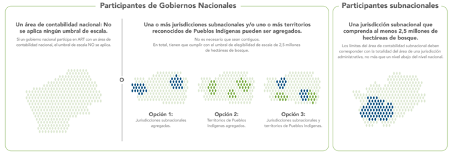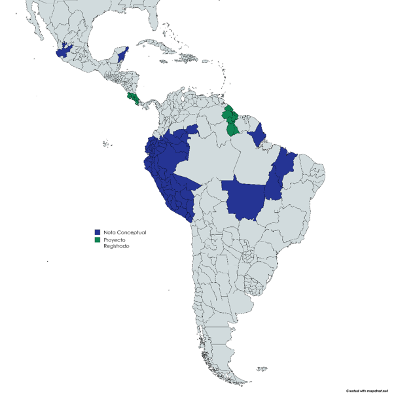Summary of the Seventh Session of the Working Group on Safeguards and Integrity of the UN-REDD Programme in Latin America and the Caribbean, held from 3-4 October 2024.
Introduction
The Seventh Session of the Safeguards and Integrity Working Group of the UN-REDD Programme in Latin America and the Caribbean (LAC), led by the United Nations Environment Programme (UNEP), was held on 3-4 October 2024. This workshop focused on the safeguards requirements of the "REDD+ Environmental Excellence Standard" of the REDD+ Transaction Architecture (ART), more commonly referred to as "TREES". This standard was created for the quantification, monitoring, reporting and verification of Greenhouse Gas (GHG) emission reductions and removals from REDD+ activities at jurisdictional and national scales.
The meeting brought together safeguard experts and government representatives from the region. It included theoretical and practical sessions designed to strengthen the understanding and application of TREES safeguards requirements in national and sub-national contexts. Throughout the sessions, key issues such as the standard's validation and verification processes were addressed, highlighting the importance of adhering to principles of transparency, inclusive participation and protection of human rights.
Day 1: Training
Shared presentations
The first day began with a welcome speech by Judith Walcott, Coordinator of the UNEP LAC UN-REDD Team. In her opening presentation, Walcott highlighted the importance of the different sources of financing for REDD+, including payments for results and carbon markets, each with their particularities and requirements on safeguards. The UN-REDD Programme is supporting countries and jurisdictions to strengthen the environmental and social integrity of REDD+ and to enhance their access to forest and climate finance.
Walcott highlighted that the UN-REDD Programme, in the framework of its Technical Assistance, is supporting several countries and jurisdictions to prepare concept notes and registration and monitoring documents for ART-TREES. Given the region's growing interest in this standard, she said the Safeguards and Integrity Working Group session would serve as a space for discussion, exchange of experiences and training for the same.
The first presentation was given by Mariano Cirone, senior safeguards expert of the UNEP LAC Team for UN-REDD. Cirone detailed how ART has its methodology known as the "REDD+ Environmental Excellence Standard" (or "TREES"), which allows for the quantification, monitoring, reporting and verification of emission reductions from REDD+ activities at the jurisdictional level, and both at national and subnational scales, as long as certain requirements are met (Image 1).

Figure 1. Scales at which ART-TREES operates. Source: TREES Scales infographic
In turn, TREES allows jurisdictions to issue credits for activities such as carbon removals for establishing new forests on land without forest cover; for emission reductions from reducing deforestation and forest degradation (REDD+); and offers a special modality for emission reductions and removals in jurisdictions that have extensive forest cover and low deforestation rates (High Forest cover, Low Deforestation or "HFLD"). HFLD was added in TREES version 2.0, with the aim of "providing a pathway that encourages jurisdictions to keep their forests standing and will create a more effective and equitable global system for forest protection and restoration" (for more information see ART's HFLD Baseline Guidance and FAQs). The process that jurisdictions must follow to issue credits under TREES is detailed in Figure 2.

Process to follow for programme registration and credit issuance under ART. Source: TREES Standard v 2.0.
TREES is based on the Cancun Safeguards of the United Nations Framework Convention on Climate Change (UNFCCC), therefore while respecting the extensive processes that countries and jurisdictions have developed over the last decade, it sets out several predetermined topics and indicators that must be reported by jurisdictions wishing to access the standard. More precisely, TREES divides the 7 Cancun Safeguards into 16 key themes with 44 structure, process and outcome indicators, with specific guidance to be reported in the validation and in each monitoring report. To achieve this information, Cirone explained that jurisdictions can adapt their existing safeguards systems; choose how to apply and report on the safeguards; and design their own benefit-sharing systems and grievance mechanisms to meet TREES requirements, while respecting their sovereignty.
Emilia Anselmo, from the UNEP Team, then reviewed the state of ART-TREES in the region, noting that in recent years, several countries across Latin America and the Caribbean have taken important steps in the implementation of REDD+ programmes under this standard. To this end, Anselmo presented a virtual tour of the participating jurisdictions (Image 3).

Participation Status of Latin American and Caribbean countries in ART-TREES. Source: own elaboration, based on ART (n.d.). ART registry. ARTREDD. https://www.artredd.org/art-registry/
As part of this, Anselmo highlighted the "REDD+ Amazon Indigenous REDD+" (RIA) programme. RIA is an initiative promoted by the Asociación Nacional de Ejecutores de Contrato de Administración (ANECAP), the Comisión Nacional de Áreas Naturales Protegidas (CONANP) and other actors, which seeks to certify a jurisdictional programme in an indigenous territory in Peru. RIA includes a culturally sensitive approach, in which the Indigenous Peoples themselves are implementing partners and not just "beneficiaries". In the framework of this Programme, the Grupo de Pueblos Indígenas de Perú - which includes ANECAP, the Asociación Interétnica de Desarrollo de la Selva Peruana (AIDESEP) and CONAP- and the Peruvian Ministry of Environment (MINAM) recently presented the first Indigenous Jurisdictional REDD+ Concept Note, which is a milestone for the region due to the uniqueness of the approach and type of project.
The presentation by Jessica Gallegos, Climate Change Mitigation Specialist of the Ministry of Environment, Water and Ecological Transition of Ecuador (MAATE), gave a detailed overview of how Ecuador has approached the elaboration of its Registration Document under the TREES standard. The country submitted the Registration and Monitoring documentation in July 2024, as well as the country's legal documentation, in order to activate the ART account. Currently, the ART Secretariat is carrying out the first review of the documentation. For this purpose, Ecuador has used the Safeguards Information Summaries (RIS) developed by the country, as well as tools such as PLANT and guides developed with the support of the UN-REDD Programme to identify information gaps and develop the necessary documentation. In addition, Ecuador already has a strong team and focal points within MAATE, also supported by the UN-REDD Programme, which allowed it to move forward in generating key inputs towards the programme's registration.
Among the challenges identified, it was highlighted that some TREES safeguards indicators were not considered in the country's first TREES registers, such as the RIS, which required adjusting national processes to ensure that the generation of safeguards information complied with the requirements of the standard.
Another important challenge was to avoid redundancy of information between the TREES Registration Document and the monitoring one, as both formats are similar. In addition, Gallegos pointed out that the process of validation and verification of safeguards information can be complex, especially given the social context and the cultural and linguistic diversity of the country, which sometimes differs significantly from that of the verifying and validating bodies (or "VVBs"). Finally, she highlighted other challenges faced during the REDD+ programme registration process for ART's, such as the scaling up of free, prior and informed consent (FPIC) and grievance mechanisms, and benefit sharing at the jurisdictional level. Although Ecuador has made progress in this area, it is still necessary to strengthen mechanisms such as benefit sharing, consultation and participation and others associated with the design and implementation of REDD+.
Highlights from Peru
Henry Dyer, UNEP consultant for the Climate Change Directorate of Peru, gave a presentation on the experiences and reflections of the implementation of ART-TREES in his country.
On the country’s progress in its approach to safeguards, Henry commented that Peru has developed a National Interpretation of the Cancun Safeguards had presented its First RIS, and is about to submit its second RIS to the UNFCCC. For this reporting process, he highlighted the usefulness of having a standardized matrix where compliance with each safeguard is recorded. The country has also developed a Safeguards Guideline document, which seeks to regulate and articulate the requirements on safeguards reporting in the framework of the National Mitigation Registry (RENAMI) and the Safeguards Information Module (MIS). This Safeguards Guideline was socialized and received inputs from public sector agencies and Peruvian society groups, in particular indigenous groups, making use of governance spaces such as the Indigenous Peoples' Platform for Climate Change. All of these inputs were very useful for developing safeguards reports such as those needed for TREES.
In relation to the standard, Dyer said Indigenous Peoples' organizations were heavily involved in the RIA proposal, (introduced by UNEP’s Anselmo earlier) which was then presented to ART with representation from more than 900 native communities and communal reserves in the Peruvian Amazon, covering approximately 10 per cent of the Amazon ecoregion. The government is currently discussing the most relevant governance mechanisms to move forward with a High Integrity Initiative. Finally, Dyer mentioned that Peru already had a Concept Note at the national level for the whole of Amazonia, which should be compatible with the RIA proposal.
Final highlights on the first day
Victoria Suárez, UNEP's global focal point for safeguards for the UN-REDD Programme, closed the day by reflecting on how the ART-TREES standard had prompted a rethink of the safeguards processes in the region, opening new opportunities and setting new standards. He stressed that the UN-REDD Programme continued to support the strengthening of national safeguard processes, while building capacities in the countries to address these new challenges and take advantage of the opportunities that arise in the future.
Day 2: Validation and verification process (practical exercise)
The second day of the event was dedicated to the practical application of the concepts learned during the theoretical day, with a focus on the ART-TREES validation and verification process carried out by the Validation and Verification Bodies (VVB).
Training day
Lucía Madrid, Deputy Director of Policy at ART, gave a training presentation on the validation and independent verification process required by TREES participating programmes. She explained that an initial validation is required to register the jurisdictional REDD+ programme in the standard, as well as a verification in year one and additional verifications in years three and five to issue carbon credits for the verified reduced emissions. During the initial validation, baseline data, crediting level calculations, safeguard compliance and monitoring mechanisms are checked. In verifications, the implementation and results of actions are assessed. The VVB examines various aspects, such as technical and legal eligibility, the application of monitoring tools, carbon credit entitlements and the tracking of Cancun safeguards indicators.
Validation and Verification Process
This process follows a well-defined structure that ensures compliance with TREES requirements, including safeguards (see Figure 4). First, the participating jurisdiction engages a VVB that conducts an independent audit to assess compliance with TREES requirements. The ART Secretariat reviews potential conflicts of interest before starting the audit process, which begins with an initial meeting between the VVB and the participant to present the validation or verification plan. This is followed by interviews, field visits and a thorough review of evidence, such as forest data, satellite images and community records, among others. This evidence allows the VVB to verify the reported information and issue its findings.

For the evaluation of the safeguards’ indicator report, the registration process culminates in a meeting where the VVB presents a final report classifying the findings for each indicator into four categories:
- Major non-conformity: Materially impacts emission reductions or affects the participant's ability to meet TREES requirements.
- Minor non-compliance: The problem is limited and does not compromise overall compliance.
- Observation: An issue identified by the audit team that does not have objective evidence to constitute a non-conformity but may lead to one in the future.
- Clarification request: Further information is required.
The final report is reviewed and approved by the ART Board.
It is a recurrent practice that initial validation and year one verification are done at the same time, however, they are two distinct processes with their own requirements and particularities.
Practical Exercise
After the training, attendees participated in a practical exercise led by Madrid, focusing on the process of validation and verification of programmes by VVBs. Participants organized themselves into groups and worked on a fictitious case study of a jurisdiction. Each group took on the role of a VVB, assessing compliance with an outcome indicator and formulating findings. During the activity, best practices for collecting adequate evidence and how to classify findings into major non-conformities, minor non-conformities, clarification requirements or observations were discussed.
This exercise allowed participants to apply the concepts learned and to experience in a practical way the challenges faced by a VVB. It also helped them to understand the importance of presenting accurate evidence to optimize the verification process of safeguard indicators.
Conclusions
- GBV faces complex challenges due to the diversity of actors, scenarios and socio-cultural risks. This requires a thorough review of each element before a final decision is made, with adequate evidence and understanding of the local context being essential.
- VVBs must analyze a wide variety of evidence, ranging from forestry data to community records and field visits, to ensure that the reported results are reliable and meet TREES requirements.
- It is common for a programme to receive a "non-compliance" assessment on a safeguard indicator; however, there is always the possibility to rectify the information or submit new action and monitoring plans to ensure adequate compliance.
Final highlights
The final session ended with a talk by UNEP’s Suárez, who highlighted the importance of continuing to strengthen local and regional capacities for the implementation of safeguards under ART-TREES. Suárez highlighted that the commitment of jurisdictions to transparency, inclusion and protection of rights is key to the success of REDD+ projects in the region. She also underlined the relevance of exchanges of experiences such as those experienced in this session, which allow for the identification of valuable lessons and the replication of good practices in other contexts.
The seventh session of the Working Group on Safeguards and Integrity of the UN-REDD Programme in Latin America and the Caribbean, in brief:

participants

countries represented

UN agencies

session minutes
About the Working Group
The Safeguards and Integrity Working Group of the UN-REDD Programme in Latin America and the Caribbean is a space made up of staff and experts working on the design, implementation and monitoring of REDD+ safeguards in the region, with the objective of sharing experiences, good practices, common challenges and lessons learned, in order to improve the implementation, monitoring and reporting of safeguards and strengthen the environmental and social integrity of REDD+ in LAC.
For more information about the work, please contact the UNEP team through Mariano Cirone at mariano.cirone@un.org.